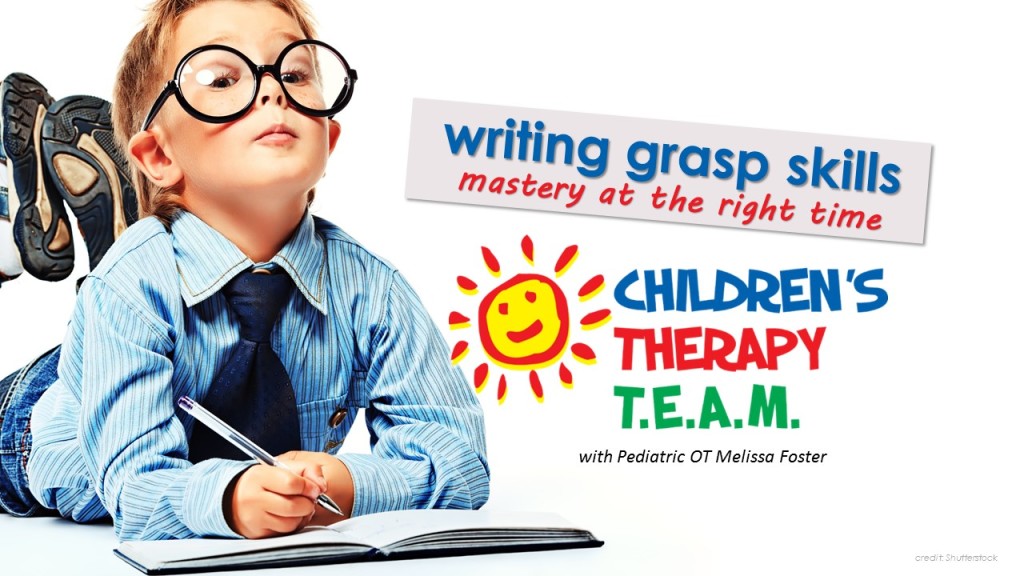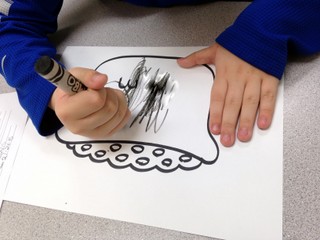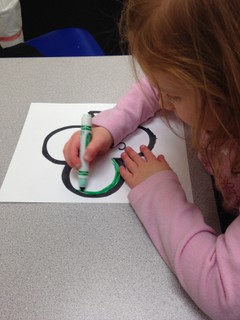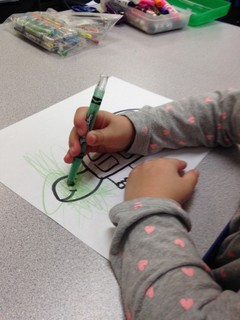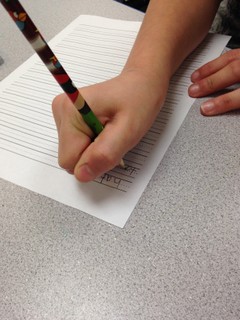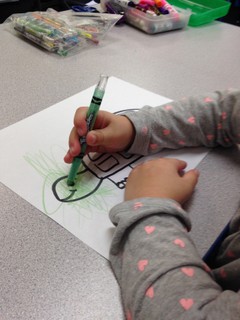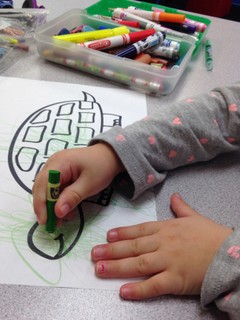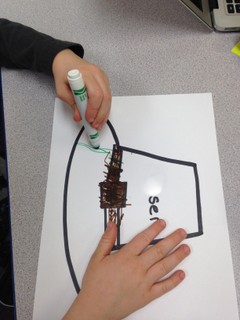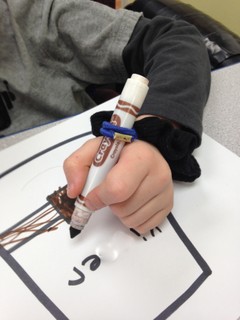Dear Melissa,
I am a preschool teacher. It seems as if every 4 year old in my classroom holds the crayon differently. How do I best help them to develop a proper pencil grasp?
This is a question I get from a lot of teachers, parents, and even fellow therapists. Actually, I probably get this question most from my fantastic speech therapist colleagues who are trying to squeeze a bit of OT into their speech therapy sessions. Now that is dedication to your clients!
First, let’s take a look at: TYPICAL GRASP DEVELOPMENT
Palmar/Gross Grasp (1-1.5 years of age)
For this grasp, the whole marker is placed in the palm of the hand. The arm is in neutral and the whole arm moves the marker with the whole hand wrapped around the marker.
Pronated Grasp (2-3 years of age)
Child will begin to hold the marker in the fingers rather than in the palm of the hand. His/her elbow is generally elevated off of the table.
Immature 5 Finger Grasp (3.5-4 years of age)
The marker is positioned more in the child’s finger tips, but all of the fingers are used to help guide the marker.
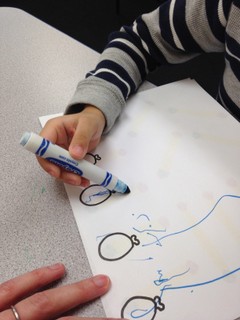 NOTE: Many children begin to favor one hand or the other as early as 1 year of age, but hand dominance is often not firmly established until 3-4 years of age. If hand dominance has not been established by shortly after 4 years of age, then the occupational therapist will engage the child in a variety of fine and gross motor tasks in order to help determine the child’s true preference of hand dominance.
NOTE: Many children begin to favor one hand or the other as early as 1 year of age, but hand dominance is often not firmly established until 3-4 years of age. If hand dominance has not been established by shortly after 4 years of age, then the occupational therapist will engage the child in a variety of fine and gross motor tasks in order to help determine the child’s true preference of hand dominance.
Static Quadrupod Grasp (4-5 years of age)
Only the thumb and the first 2-3 fingers touch the marker, but the hand is generally static, and the writing motions come from the whole arm rather than just the fingers.
Dynamic Tripod/Quadrupod Grasp (5-6 years of age)
The marker is held by only the thumb and the first 2-3 fingers, with the marker placed in the web space between the index finger and the thumb. The motions from the marker are coming from the fingers rather than the wrist or the whole arm.
So you think you have a kiddo, either at home or in the classroom, who is demonstrating a grasping pattern that is immature for his/her age. What can you do? First of all, if the child is over the age of 7 years old, the common rule of thumb amongst occupational therapists is that the child’s grasping pattern is already fairly fixed, and that changing the grasp after this age will just lead to more handwriting struggles rather than improved handwriting skills. Trust me, I know many doctors, lawyers, and even occupational therapists who have “wonky” grasps! But, if you are writing/coloring with a child who is under the age of 7, attempting to fix an immature grasping pattern can dramatically improve writing speed, accuracy, and fluidity. So let’s get to work!
GRASP INTERVENTION
The following pictures depict several “problem grasps”. Many times children will wrap their entire thumb around the pencil, hold the pencil with too many fingers, or attempt to hold the pencil in the palm of their hand, especially when fatigued. Here are some examples of problem grasps and how to approach modifying them:
Thumb Wrapping or 5 Finger Grasp: If the child is showing an immature grasp by putting too many fingers on the pencil, or wrapping his/her thumb around the pencil, give the child shortened crayons or shortened pieces of chalk so that only 3 fingers will fit on the writing utensil instead of all 5 fingers. The following “before” and “after” pictures show a pre-school child coloring on the same turtle picture. Simply changing the writing utensil greatly and instantaneously improved the child’s grasp. But, a word of warning: if you give the longer crayon back to the child, he/she will immediately go back to the more immature grasp. Therefore, it is important to keep lots of writing/coloring tools that promote the more mature patterns.
Thumb Hyperextension: If the child is holding the pencil so that his or her distal thumb joint is bent backward (hyperextended), then you can make a really simple tool using hair ties to place the pencil back in the web space between the index finger and the thumb where it belongs. This will encourage the thumb to curl slightly around the pencil, providing more stability and control, rather than having the thumb bent backward with less contact on the pencil. Simply loop two hair ties together, place one of the loops of the hair ties around the child’s wrist and the other loop around the child’s pencil. Again, this will help position the pencil correctly in the web space. Once the child becomes more comfortable with the pencil in this position, you can then draw a “happy face” in the web space of the dominant hand and remind the child to “let the pencil sleep on his pillow.”
Other general grasp solutions:
- Pencil grippers: There is no one pencil gripper that is best for a particular child. I keep a selection at the clinic, and it is generally just trial and error.
- Vertical surface: Use a chalk board or tape a worksheet to the wall. This helps put the wrist in a proper extended position and keeps the elbow from being raised off of the table.
- Slant board: Sometimes a child needs to sit at a table and can’t always use a wall. In this case, a slant board resting on the desk top can also work like a vertical surface, when using a wall is simply not practical.
- Resistance: Chalk and crayons are more resistive than markers, and much more resistive than Expo markers on a wipe off board. This resistance helps the child slow down and control their fine motor movements.
- Strengthen: Not just strengthening the hand and fingers, but strengthening the whole arm as well. Consider animal walks and crawling obstacle courses to strength the whole arm, as well as play-doh, tongs, clothespins, and sidewalk chalk to strengthen fingers.
OK all of you parents, teachers, and OT’s out there, let me know how you help your little ones hold the pencil correctly! I would love to hear your ideas! share@childrenstherapyteam.com

